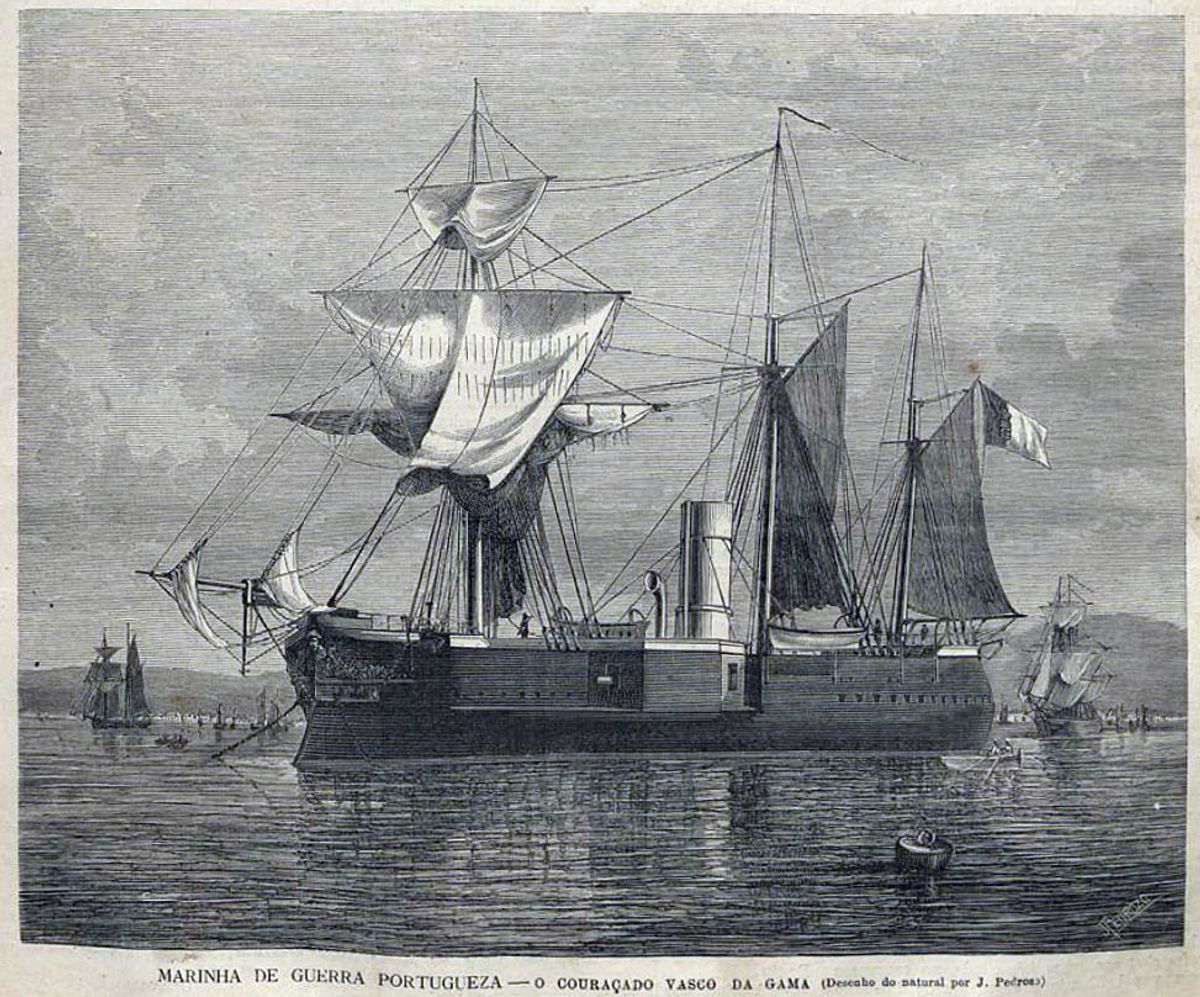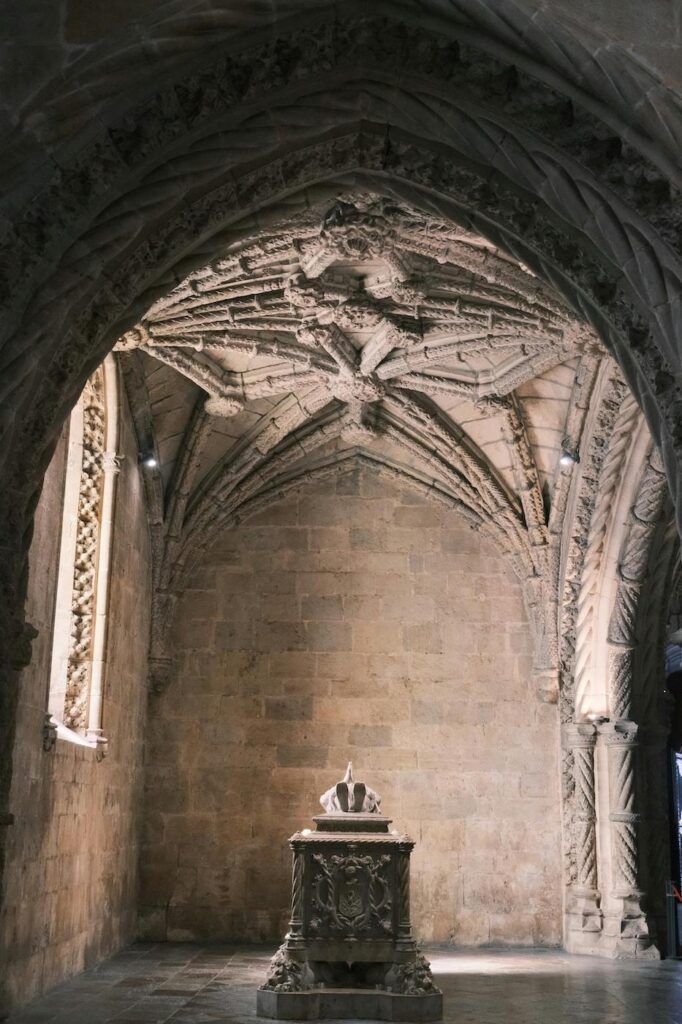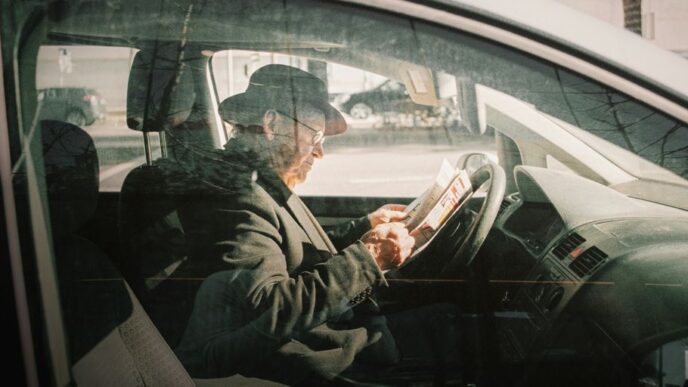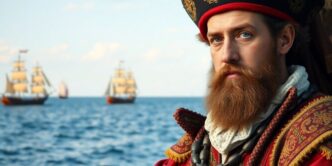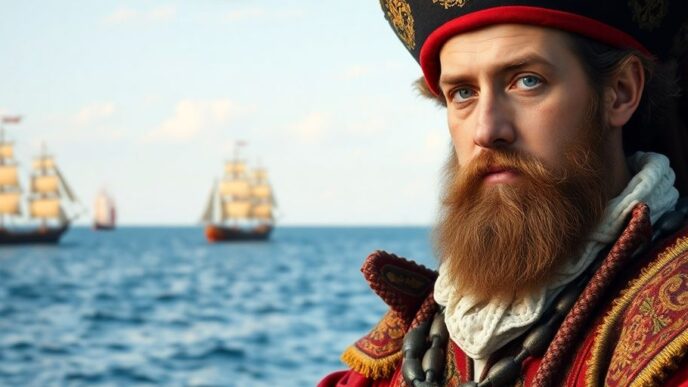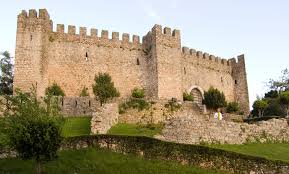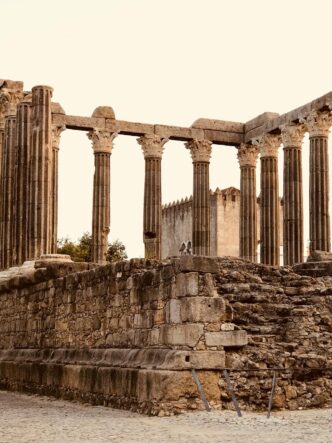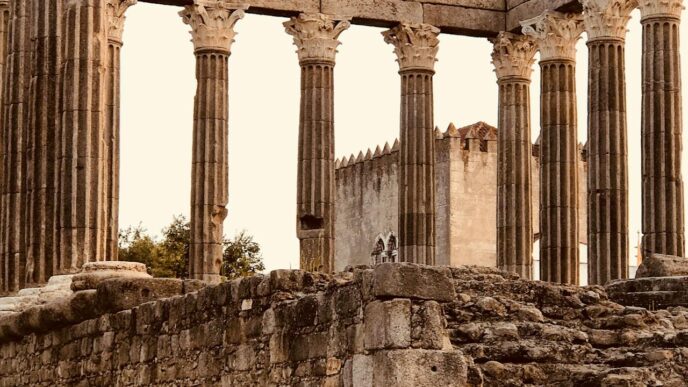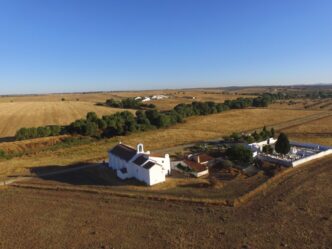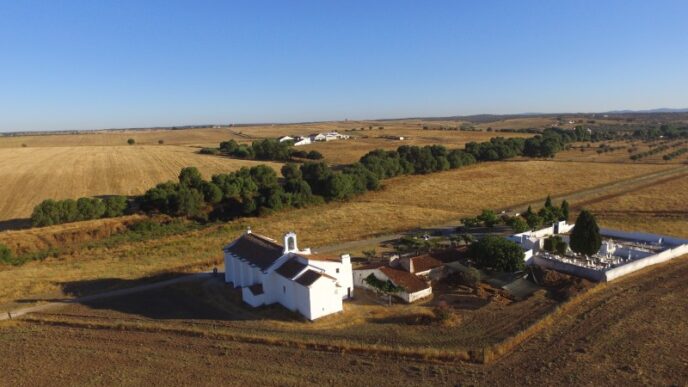Vasco da Gama, a name synonymous with exploration and discovery, stands tall among the legendary figures of the Age of Discovery. His groundbreaking voyage to India at the close of the 15th century not only shattered the Venetian and Arab monopoly on the spice trade but also paved the way for an era of global maritime trade. This article delves into the life and monumental discoveries of Vasco da Gama, whose voyages had far-reaching implications that reshaped the world’s economic and cultural landscapes.
The Pioneering Voyage to India
Preparation and Departure from Lisbon
Upon the departure from Lisbon on July 8th, 1497, Vasco da Gama embarked on a historic journey that would reshape global trade and exploration. Guided by the seasoned navigator Bartolomeo Diaz, the fleet set sail towards the Canary Islands, followed by a strategic detour to the Cape Verde Islands. Diaz’s expertise proved invaluable as he recommended a west-south-west course across the Atlantic, skirting the doldrums of the Gulf of Guinea.
The fleet’s navigation strategy was a testament to the evolving understanding of the world’s oceans and prevailing winds.
This unconventional route brought them within a mere 1000 kilometers of the Brazilian coast before the southwest winds propelled them towards the southern tip of Africa. By November 7th, they had sighted the African continent, marking a significant milestone in their voyage.
The preparation and departure from Lisbon were not merely the beginning of a voyage; they were the first steps in establishing a maritime legacy that would endure for centuries.
Navigational Challenges and the Atlantic Crossing
Upon setting sail from Lisbon, Vasco da Gama and his crew faced the daunting task of navigating uncharted waters. The Atlantic crossing was a perilous journey, fraught with unknown dangers and the constant threat of scurvy. Despite these challenges, da Gama’s fleet pressed on, driven by the promise of discovering a sea route to India.
The crossing of the Atlantic was not just a test of endurance but a pivotal moment in maritime history, marking the beginning of a new era in global exploration.
The crew’s resilience was tested as they maneuvered around the Cape of Good Hope, a feat previously achieved by Bartolomeu Dias. This strategic move not only proved the connection between the Atlantic and Indian Oceans but also dispelled the geographical misconceptions of the time. The table below summarizes the key milestones of this segment of the voyage:
| Milestone | Date | Description |
|---|---|---|
| Departure from Lisbon | July 8, 1497 | The beginning of the historic journey. |
| Rounding the Cape of Good Hope | November 22, 1497 | A crucial navigational achievement. |
| Crossing the Equator | March 12, 1498 | Entering the Southern Hemisphere. |
The successful navigation of these challenges laid the groundwork for the eventual arrival in Calicut, setting the stage for a new chapter in the history of trade and exploration.
Arrival in Calicut and Interaction with the Zamorin
Following the tense interactions in Calicut, Vasco da Gama’s expedition faced the daunting task of returning to Portugal with the precious spices they had managed to acquire. Despite the initial warm reception by the Zamorin, the Portuguese soon found themselves at odds with the established Muslim traders, who viewed the newcomers as a threat to their commercial dominance. The Portuguese contingent, realizing the inadequacy of their trade goods, scrambled to amass a cargo worthy of the voyage home.
The departure from Calicut marked a pivotal moment in the expedition, as da Gama’s fleet set sail with a newfound understanding of the complexities of trade and diplomacy in the Indian Ocean.
The return journey was not without its perils. Da Gama’s ships navigated treacherous waters, contended with unpredictable monsoon winds, and faced the hostility of local rulers along the coast. The expedition’s survival hinged on their navigational prowess and the strategic alliances they managed to forge.
Upon their triumphant return to Portugal in 1499, the impact of their journey began to resonate. The successful establishment of a sea route to India was a monumental achievement, heralding a new era in global trade. The Portuguese crown, recognizing the strategic importance of the route, wasted no time in planning subsequent voyages to secure their foothold in the lucrative spice trade.
The Return to Portugal and Aftermath
Following Vasco da Gama’s pioneering journey, the geopolitical landscape of maritime trade underwent a significant transformation. The successful return of da Gama’s fleet to Portugal not only marked the completion of a historic maritime route but also heralded a new era of global commerce. The Treaty of Tordesillas, signed in 1494, played a pivotal role in this transformation, delineating spheres of influence between Portugal and Spain and ensuring Portuguese control over the lucrative eastern trade routes.
The return of Vasco da Gama from India was a turning point that solidified Portugal’s position as a dominant maritime power and set the stage for an age of exploration and conquest.
The strategic importance of the spice trade was underscored by the immediate actions of the Portuguese crown. King John II’s delight at the treaty’s terms underscored the value placed on these new trade opportunities. The subsequent voyages and the establishment of a maritime trade route to India would not only enrich Portugal but also reshape global trade patterns.
| Year | Event |
|---|---|
| 1494 | Treaty of Tordesillas signed, dividing the Atlantic between Portugal and Spain. |
| 1498 | Vasco da Gama’s first arrival in Calicut, India. |
| 1499 | Successful return of da Gama to Portugal, marking the opening of a sea route to India. |
The aftermath of da Gama’s voyage saw Portugal’s maritime prowess reach new heights, with subsequent expeditions further entrenching its position in the Indian Ocean trade network. The era of exploration that followed would forever change the course of world history.
Establishing the Maritime Trade Route
The Significance of the Spice Trade
The quest for spices such as pepper, cinnamon, and cloves drove European explorers to seek new trade routes. The spice trade was not merely a commercial venture; it was a catalyst for global exploration, shaping economies and geopolitics.
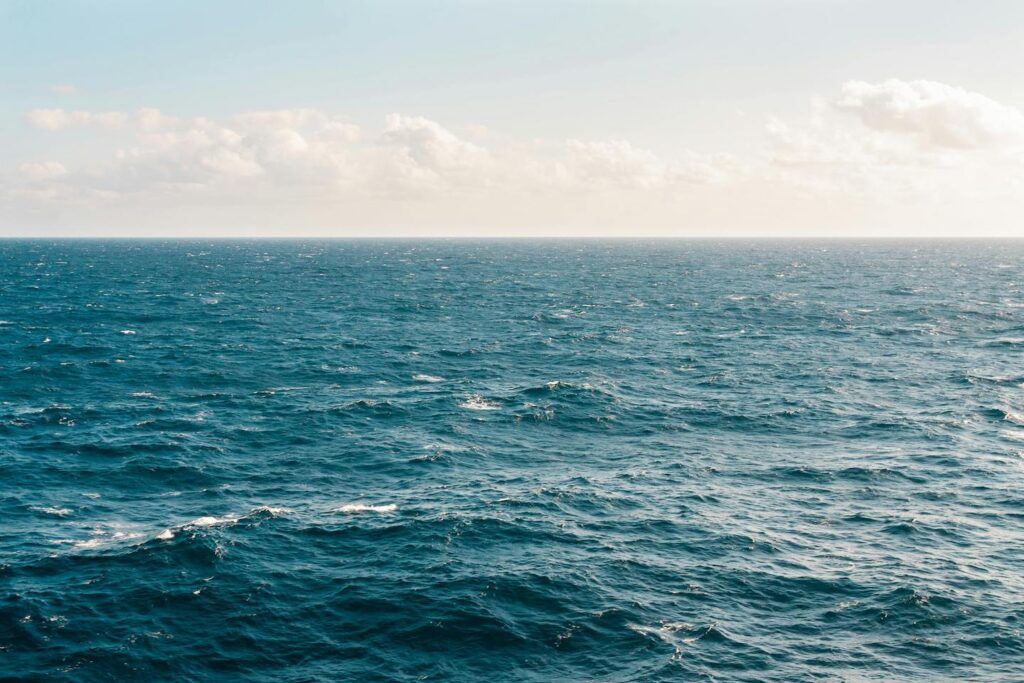
- Spices were highly valued for their use in preserving food, medicine, and enhancing flavor.
- Control over the spice trade signified economic power and influence.
- The monopoly held by Arab and Venetian merchants dictated high prices in European markets.
Vasco da Gama’s voyage disrupted the established trade dynamics, ushering in an era of European maritime dominance.
The establishment of a direct maritime route to India by Vasco da Gama marked a turning point. It allowed Portugal to bypass the overland and Mediterranean trade networks, reducing costs and increasing profits. This strategic shift had profound implications:
| Factor | Before da Gama | After da Gama |
|---|---|---|
| Trade Route | Overland and Mediterranean | Direct maritime route |
| Control | Arab and Venetian merchants | Portuguese Crown |
| Spice Prices | High due to intermediaries | Lowered by direct access |
Da Gama’s success laid the groundwork for a global trading network, with Portugal at its helm. The ripple effects of this new trade route were felt across continents, altering the course of history.
Strategic Movements and the Arabian Sea Crossing
Following the strategic navigation around the Cape of Good Hope, Vasco da Gama’s fleet capitalized on the monsoon winds to cross the Arabian Sea. The journey, taking a mere 27 days, was a testament to the navigational prowess of the time, facilitated by the recruitment of experienced sailors, including possibly the renowned Arab navigator Ahmen Ibn Majid. This swift crossing was crucial in establishing a direct maritime route to the lucrative spice markets of India.
Upon reaching the Malabar coast, the Portuguese were poised to tap into the epicenter of the spice trade, primarily the highly sought-after Kerala pepper. The region was not only a hub for local commodities but also a nexus for broader trade networks, where ships from the Moluccas came to exchange exotic goods with Arab merchants.
The successful Arabian Sea crossing marked a pivotal moment in maritime history, setting the stage for a new era of global trade and European expansion.
The strategic movements across the Arabian Sea were underpinned by prior reconnaissance. Pedro de Covilha’s overland journey to India, while perilous, yielded invaluable insights into Muslim ports and trade dynamics along the East African and Indian coasts. These findings laid the groundwork for da Gama’s expedition and the subsequent establishment of a permanent trade route.
Diplomatic Endeavors and Trade Negotiations
Following the strenuous diplomatic endeavors and trade negotiations, Vasco da Gama’s voyages had profound implications for global commerce. The direct maritime route to India circumvented the traditional land routes dominated by Middle Eastern powers, thereby reshaping the spice trade and altering the balance of trade power.
- The establishment of a sea route to India provided Portugal with a strategic advantage in the lucrative spice trade.
- Portuguese control over this trade route led to the decline of Venetian and Ottoman trade dominance.
- The success of these voyages spurred other European nations to explore and establish their own trade routes, heralding the age of discovery.
The opening of the maritime route to India by Vasco da Gama marked the beginning of a new era in global trade, one that saw the rise of European maritime powers and the creation of a truly global economy.
Legacy and Impact on Global Commerce
Vasco da Gama’s pioneering voyage not only established a direct maritime route to India but also marked the beginning of a new era in global trade. His journey broke the Arab and Venetian monopoly on the spice trade, ushering in an age of European dominance in maritime commerce. The Portuguese explorer’s success paved the way for a surge in global exploration, leading to the discovery of new lands and the expansion of international trade networks.
The economic impact of da Gama’s voyage was profound. The influx of spices and other exotic goods into Europe altered consumption patterns and fueled the growth of European economies. The strategic importance of controlling sea routes to the East became a central aspect of European foreign policy, leading to the establishment of colonial empires and the redistribution of global power.
The establishment of the maritime trade route to India by Vasco da Gama was a catalyst for change, setting in motion a series of events that reshaped the world’s economic and political landscapes.
The cultural implications were equally significant. The exchange of goods also meant the exchange of ideas, customs, and technologies, contributing to a more interconnected and culturally diverse world. The Santa Maria Church, a symbol of the era, embodies Portuguese architecture with its Manueline style. Similarly, Óbidos, now a UNESCO City of Literature, celebrates the rich literary culture that flourished during this period of exploration and discovery.
Conclusion
Vasco da Gama’s monumental voyages reshaped the global landscape of trade and geopolitics, forging a new era of maritime exploration and cultural exchange. His pioneering journey to India in 1498, overcoming treacherous seas and navigational challenges, not only broke the Arab and Venetian stranglehold on the lucrative spice trade but also marked the beginning of European colonialism in Asia. Da Gama’s expeditions exemplify the audacious spirit of the Age of Discovery, where the quest for knowledge and wealth drove humanity to expand its horizons. His legacy, a complex tapestry of triumph and tragedy, continues to be studied and debated by historians, reflecting the profound impact of his voyages on the course of world history.
Frequently Asked Questions
What was the significance of Vasco da Gama’s voyage to India?
Vasco da Gama’s voyage to India was significant because it established the first maritime trade route between Europe and India. This broke the monopoly of Arab and Venetian merchants on the spice trade and marked a new era in global commerce.
How did Vasco da Gama navigate to India?
Vasco da Gama navigated to India by sailing along the African coast, beyond the Cape of Good Hope, and then crossing the Arabian Sea with the help of favorable winds. His navigational route was advised by Bartolomeo Diaz, which included a wide swing into the Atlantic Ocean to avoid the doldrums near the Gulf of Guinea.
What challenges did Vasco da Gama face during his voyage?
During his voyage, Vasco da Gama faced numerous challenges, including navigational difficulties, harsh weather conditions, scurvy, and conflicts with local rulers and merchants. Despite these challenges, he successfully reached Calicut and established contact with the Zamorin, the local ruler.

